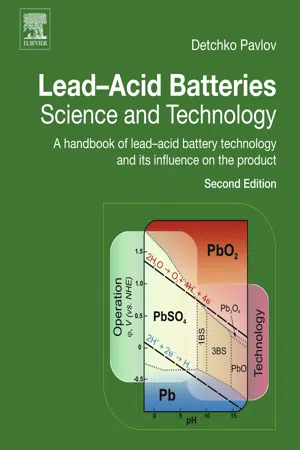
Lead-Acid Batteries: Science and Technology
A Handbook of Lead-Acid Battery Technology and Its Influence on the Product
- 720 pages
- English
- ePUB (mobile friendly)
- Available on iOS & Android
Lead-Acid Batteries: Science and Technology
A Handbook of Lead-Acid Battery Technology and Its Influence on the Product
About This Book
Lead-Acid Batteries: Science and Technology: A Handbook of Lead-Acid Battery Technology and Its Influence on the Product, Second Edition presents a comprehensive overview of the technological processes of lead-acid battery manufacture and their influence on performance parameters. The book summarizes current knowledge on lead-acid battery production, presenting it in the form of an integral theory that is supported by ample illustrative material and experimental data that allows technologists and engineers to control technological processes in battery plants. In addition, the book provides university lecturers with a tool for a clear and in-depth presentation of lead-acid battery production in courses.
This updated edition includes new supplementary material (text and illustrations) in chapters 2, 4, 6 and 16, as well as a brand new chapter on the action of carbon as an additive to the negative active material and the utilization of the lead-carbon supercapacitor electrodes. Substantial revisions of other chapters have been made, making the book beneficial for battery researchers, engineers and technologists.
- Written by a world authority on lead-acid batteries in a comprehensive and unified manner
- Includes new chapters on lead-acid batteries operating in the HRPSoC duty for hybrid electric vehicle applications and on lead-carbon electrodes
- Presents a comprehensive overview of the theory of the technological processes of lead-acid battery manufacture and their influence on battery performance parameters
- Proposes optimum conditions for individual technological processes that would yield superior structures of the lead and lead dioxide active masses
- Discusses the processes involved in the closed oxygen cycle in VRLAB and the thermal phenomena leading to thermal runaway (TRA)
Frequently asked questions
Information
Invention and Development of the Lead–Acid Battery
Abstract
Keywords
1.1. A Prelude
Table of contents
- Cover image
- Title page
- Table of Contents
- Copyright
- Dedication
- Preface
- Acknowledgments
- Part 1. Fundamentals of Lead–Acid Batteries
- Part 2. Materials Used for Lead–Acid Battery Manufacture
- Part 3. Processes During Paste Preparation and Curing of the Plates
- Part 4. Plate Formation
- Part 5. Battery Storage and VRLA Batteries
- Part 6. Calculation of the Active Materials in a Lead–Acid Cell
- Appendices
- Index